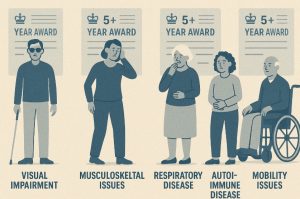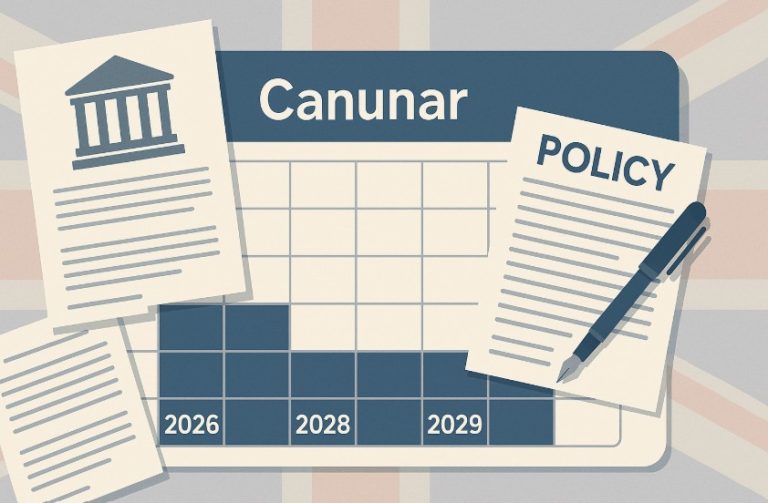Understanding the length of a Personal Independence Payment (PIP) award in 2025 is essential for individuals living with long-term health conditions or disabilities.
With more than 3.7 million people currently claiming PIP in the UK, the Department for Work and Pensions (DWP) has provided updated guidance on how long awards may last, the review process, and who qualifies for longer or ongoing awards.
This guide explores everything claimants and carers need to know about PIP award length in 2025, from award types and medical conditions to payment rates and review timelines.
What Is Personal Independence Payment (PIP) and Who Can Claim It in 2025?

Personal Independence Payment (PIP) is a financial support system provided by the UK government through the Department for Work and Pensions (DWP).
It is specifically designed to help individuals with long-term health conditions, disabilities, or mental health challenges that impact their ability to carry out daily living activities or move around independently.
PIP is available to individuals aged 16 and above, up to the State Pension age, living in England, Wales, and Northern Ireland.
In Scotland, PIP has been replaced by Adult Disability Payment (ADP), although the eligibility criteria remain broadly similar.
Claimants do not need to have a specific diagnosis to be eligible. Instead, eligibility is assessed based on how the condition affects daily life. The two components of PIP are:
- Daily Living: For those who need help with routine activities like washing, dressing, cooking, or managing medication.
- Mobility: For those who need help moving around or planning and following journeys.
Each component is paid at either a standard or enhanced rate depending on the level of need.
How Many People Are Receiving PIP in 2025?
According to recent data from the DWP, there were 3,744,671 active PIP claimants as of April 2025. This marks the highest number of recipients since the benefit was introduced in 2013.
A significant portion of this increase is due to growing public awareness and better recognition of hidden or fluctuating conditions, such as mental health disorders and neurological conditions.
Of these claimants, 1,631,688 have been awarded a Light Touch review, indicating long-term or severe conditions that require minimal reassessment.
The DWP anticipates that numbers will continue to rise into 2026, particularly with the rollout of reform proposals aimed at simplifying the disability benefit system.
How Long Does a PIP Award Last in 2025?

The length of a PIP award varies depending on the claimant’s health condition and its expected progression. Awards typically fall into a range between nine months and ten years, with a mix of short-term, medium-term, and ongoing awards.
The DWP categorises award durations into the following:
| Award Duration | Description |
| 9 months to 2 years | Short-term, usually where improvement is expected |
| 2 to 5 years | Medium-term awards, often with review dates |
| 5 years or longer | For stable or long-term conditions |
| Ongoing (10 years) | Awarded with Light Touch review, not time-limited |
The most common length for new claimants in 2025 is five years or longer, though this is often paired with a planned review date within that period.
What Factors Determine the Length of a PIP Award?
The length of a PIP award is not arbitrarily assigned; it is carefully determined by the Department for Work and Pensions (DWP) based on several key factors.
These factors aim to assess how a claimant’s condition affects their daily life and whether those effects are expected to change over time.
Each decision is made on a case-by-case basis, reflecting the uniqueness of every individual’s circumstances.
1. Stability of the Health Condition
One of the primary considerations is how stable the claimant’s condition is. If the condition is expected to improve with treatment, therapy, or time, the award is more likely to be short-term.
Conversely, if the condition is permanent, degenerative, or unlikely to change significantly, a longer or even ongoing award may be issued.
2. Medical Evidence Provided
The quality and quantity of medical documentation submitted with the application plays a crucial role.
Reports from GPs, consultants, physiotherapists, mental health specialists, and occupational therapists can all support a strong case. Clear, consistent evidence helps the DWP understand whether the needs are temporary, fluctuating, or enduring.
3. Assessment Reports
If required, claimants attend an independent PIP assessment conducted by a health professional.
The assessor’s report includes detailed observations and recommendations which are heavily considered when deciding the award’s length.
Factors like the frequency and severity of symptoms, medication side effects, and real-world functionality all contribute to this analysis.
4. Impact on Daily Living and Mobility
It’s not just about the diagnosis but how the condition impairs the claimant’s ability to function in daily life.
Difficulty with personal care, preparing meals, managing money, and moving around are all critical indicators of need. If these difficulties are likely to persist long-term, the award length may be extended accordingly.
5. Potential for Improvement or Deterioration
Some conditions, such as recovery from surgery or a temporary injury, may show a high likelihood of improvement.
Others, like progressive neurological diseases or certain mental health conditions, may worsen over time. The DWP considers prognosis, supported by medical input, when deciding whether to schedule future reviews.
6. Previous Benefit History
For existing claimants transitioning from Disability Living Allowance (DLA) to PIP, or from an earlier PIP award, the DWP also reviews the length and type of past benefits received.
A history of long-term awards may influence the likelihood of receiving an ongoing or longer-term award.
By examining these combined elements, the DWP aims to set an award length that is both fair and reflective of the claimant’s actual support needs, while also ensuring public funds are used responsibly.
What Are the Different Types of PIP Awards?

PIP awards are structured to accommodate a wide range of disabilities and health conditions, from temporary injuries to lifelong impairments.
The type of award issued determines how long a claimant receives support before undergoing a review or needing to reapply.
The DWP outlines three main types of PIP awards: Fixed-Term Awards, Limited-Term Awards without Review, and Ongoing Awards with Light Touch Reviews.
1. Fixed-Term Awards with Scheduled Review
These are the most common type of award for people with fluctuating or potentially treatable conditions. A fixed-term award typically lasts between two and five years, and includes a planned review date set before the award expires.
The purpose of the review is to determine whether the claimant’s condition has changed significantly. Depending on the findings, the award may be renewed, adjusted, or ended.
Key features of fixed-term awards:
- Scheduled reassessment before the end of the award
- Suitable for conditions where improvement or change is likely
- May involve a new form or assessment at review time
2. Limited-Term Awards Without Review
These awards are generally short-term, often up to two years, and are issued when a claimant’s health condition is expected to improve significantly or resolve entirely during that period. In these cases, the DWP does not schedule a review, and the award ends automatically.
Claimants must submit a new application if they continue to need support after the end of the limited award period.
When limited-term awards are typically given:
- Recovery expected after treatment or surgery
- Mild to moderate conditions with good prognosis
- Temporary mental health or physical impairments
3. Ongoing Awards with Light Touch Reviews
Ongoing awards are issued in cases where the claimant has a long-term, severe, or degenerative condition that is unlikely to improve. These awards are not time-limited in the traditional sense and do not have an expiry date.
Instead, claimants receive a light touch review after 10 years, which is much less intensive than a full reassessment.
The DWP typically sends a short form to confirm that the claimant’s circumstances have remained the same.
Criteria for ongoing awards include:
- Conditions considered permanent or deteriorating
- Claimants approaching or beyond State Pension age
- Claimants under Special Rules for end-of-life care
- Very high, stable support needs with no expectation of improvement
Summary Comparison
| Award Type | Typical Duration | Review Requirement | Suitable For |
| Fixed-Term (with review) | 2–5 years | Scheduled reassessment | Fluctuating or moderately stable conditions |
| Limited-Term (no review) | Up to 2 years | No review during award period | Temporary or improving conditions |
| Ongoing (Light Touch review) | Indefinite (10 yrs) | Light review every 10 years | Permanent, degenerative, or end-of-life cases |
Understanding these award types helps claimants better anticipate their responsibilities, whether preparing for reassessments or knowing when they might need to submit a new application.
It also offers reassurance to those with long-term conditions who may be eligible for less frequent reviews and more stable financial support.
Who Gets a ‘Light Touch’ Review and What Does It Involve?
A Light Touch review is intended for individuals with long-term conditions that are unlikely to change significantly. The DWP has outlined specific groups who are most likely to qualify for this type of review.
These include:
- People with high, stable care and mobility needs
- Individuals nearing or beyond State Pension age
- Claimants under the special rules for end-of-life care
- Those who are not expected to see improvement in their condition
The Light Touch review process is simplified. Instead of a full reassessment, claimants receive a short review form. There is usually no face-to-face assessment unless additional information is required.
This approach is meant to reduce the stress and administrative burden on those with lifelong or severe conditions.
Which Medical Conditions Get the Longest PIP Awards?

The DWP tracks award lengths by condition type. Certain conditions are far more likely to receive five-year or ongoing awards. These decisions are based on the likelihood of change in the claimant’s condition over time.
The table below outlines some of the health conditions with the highest percentage of five-year or longer awards, along with the number of claimants receiving Light Touch reviews.
| Condition Type | Total Claimants | Light Touch Reviews | % with 5-Year+ Awards |
| Visual Disease | 58,539 | 38,112 | 65% |
| Musculoskeletal Disease (General) | 697,476 | 365,238 | 52% |
| Neurological Disease | 472,121 | 252,214 | 53.4% |
| Respiratory Disease | 137,957 | 66,647 | 48.3% |
| Autoimmune Disease | 19,921 | 9,310 | 46.7% |
| Musculoskeletal Disease (Regional) | 440,684 | 202,317 | 46% |
These figures reflect data up to the end of April 2025. They suggest that individuals with stable but significant impairments are more likely to receive extended awards, reducing the frequency of reassessments.
What Are the Current PIP Payment Rates in 2025?
PIP payments are structured into two components: Daily Living and Mobility. Each component is paid at either a standard or enhanced rate. The payment amounts were updated for the 2025–2026 financial year.
| Component | Weekly Standard Rate | Weekly Enhanced Rate | 4-Week Maximum Total |
| Daily Living | £73.90 | £110.40 | £441.60 |
| Mobility | £29.20 | £77.05 | £308.20 |
| Combined (Max Total) | — | — | £749.80 |
PIP is paid every four weeks, so the total potential amount a claimant could receive is £749.80 per pay period, assuming they qualify for both components at the enhanced rate.
How Often Are PIP Awards Reviewed?
Even though some awards are ongoing, most PIP claimants should expect their award to be reviewed at some point. The purpose of these reviews is to ensure that the level of support still reflects the claimant’s current needs.
Review frequencies depend on the type of award:
- Limited awards (up to 2 years) are not reviewed during their term but may end without renewal unless the claimant reapplies.
- Medium-term awards (3 to 5 years) are reviewed in advance of the expiry date, often involving a new form or assessment.
- Ongoing awards (10 years) undergo a Light Touch review around the tenth year unless changes are reported earlier.
Claimants are advised to notify DWP if their condition improves or worsens during the award period, as this could prompt an earlier review.
What Should New Claimants Know About PIP Award Lengths?

Those making a new claim for PIP in 2025 should be aware that award length is not guaranteed and depends entirely on the individual case. A clear and detailed application supported by relevant medical evidence can influence the length and type of award granted.
New claimants should:
- Clearly explain how their condition affects daily life and mobility
- Include detailed examples and supporting documents
- Highlight whether the condition is expected to change over time
The more comprehensive and consistent the information provided, the more likely it is that the DWP will make an informed decision that reflects the claimant’s long-term needs.
Conclusion
Understanding PIP award lengths in 2025 is essential for anyone applying or currently receiving the benefit.
With awards ranging from nine months to ongoing support with light touch reviews, knowing how decisions are made helps claimants plan ahead.
Award durations depend on individual circumstances, medical evidence, and the impact of the condition.
Staying informed about review processes, payment rates, and eligibility criteria ensures claimants receive the correct level of support based on their long-term needs.
FAQs About PIP Award Length in 2025
What’s the shortest possible PIP award length in 2025?
The shortest award can be just nine months, especially if a health improvement is expected.
Can my PIP award be reviewed earlier than the date on my letter?
Yes. Awards can be reviewed at any time if your condition changes or if new evidence arises.
How do I increase the chances of getting a longer PIP award?
Submit comprehensive medical reports, detail daily challenges clearly, and provide supporting evidence.
Are PIP awards always reviewed face-to-face?
No. Many reviews are now paper-based or involve telephone assessments. Ongoing awards with light-touch reviews usually avoid face-to-face assessments.
What is considered a “light touch” review?
A simplified review process for long-term or stable conditions, typically occurring every 10 years.
Do all conditions qualify for an ongoing award?
No. Only conditions considered unlikely to improve and with high, stable needs may qualify.
How do I check when my PIP award ends?
Check your original award letter or contact DWP directly for your review or end date.
1. Heading: PIP Award Length 2025: How Long Will Your Award Last?
Prompt:
“An illustrated wide-angle image showing a UK government office with a disabled person speaking to an advisor at a desk. Include visual icons like a calendar, clock, and paperwork to symbolise time and duration. Use soft professional colours, British signage, and inclusive representation.”
2. Heading: What Is Personal Independence Payment (PIP) and Who Can Claim It in 2025?
Prompt:
“A wide aspect illustration showing diverse people with different disabilities (wheelchair user, person with visual impairment, someone with a walking aid) in a community setting with PIP application forms and a UK flag in the background. Include visual references to age range (young adult to elderly) and government support.”
3. Heading: How Long Does a PIP Award Last in 2025?
Prompt:
“A wide image depicting a timeline with different lengths (9 months, 2 years, 5 years, 10 years) along a road. People at different points represent claimants, with signs showing award durations. Include DWP symbols, a calendar, and professional document icons.”
4. Heading: What Are the Different Types of PIP Awards?
Prompt:
“A wide illustration showing three side-by-side panels: short-term award (with a clock), fixed-term award (with a contract document), and ongoing award (with infinity symbol and light touch stamp). Use icons and UK setting to reflect benefit system.”
5. Heading: Which Medical Conditions Get the Longest PIP Awards?
Prompt:
“A wide aspect image with six illustrated figures representing different health conditions: visual impairment, musculoskeletal issues, neurological disease, respiratory disease, autoimmune disease, and mobility issues. Each character is labelled and standing in front of a backdrop showing 5+ year award certificates.”
6. Heading: What Should New Claimants Know About PIP Award Lengths?
Prompt:
“A wide-angle illustration of a person filling out a PIP application form with help from a carer or advisor, surrounded by helpful icons like medical documents, support symbols, clocks, and question marks. UK setting, inclusive and informative tone.”






